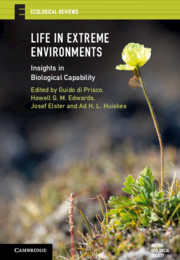Book contents
- Life in Extreme Environments
- Ecological Reviews
- Life in Extreme Environments
- Copyright page
- Dedication
- Contents
- Contributors
- Introduction
- Part I Extreme environments: responses and adaptation to change
- Chapter One Physiological traits of the Greenland shark Somniosus microcephalus obtained during the TUNU-Expeditions to Northeast Greenland
- Chapter Two Metazoan adaptation to deep-sea hydrothermal vents
- Chapter Three Extremophiles populating high-level natural radiation areas (HLNRAs) in Iran
- Part II Biodiversity, bioenergetic processes, and biotic and abiotic interactions
- Part III Life in extreme environments and the responses to change: the example of polar environments
- Part IV Life and habitability
- Index
- Plate Section (PDF Only)
- References
Chapter One - Physiological traits of the Greenland shark Somniosus microcephalus obtained during the TUNU-Expeditions to Northeast Greenland
from Part I - Extreme environments: responses and adaptation to change
Published online by Cambridge University Press: 28 September 2020
- Life in Extreme Environments
- Ecological Reviews
- Life in Extreme Environments
- Copyright page
- Dedication
- Contents
- Contributors
- Introduction
- Part I Extreme environments: responses and adaptation to change
- Chapter One Physiological traits of the Greenland shark Somniosus microcephalus obtained during the TUNU-Expeditions to Northeast Greenland
- Chapter Two Metazoan adaptation to deep-sea hydrothermal vents
- Chapter Three Extremophiles populating high-level natural radiation areas (HLNRAs) in Iran
- Part II Biodiversity, bioenergetic processes, and biotic and abiotic interactions
- Part III Life in extreme environments and the responses to change: the example of polar environments
- Part IV Life and habitability
- Index
- Plate Section (PDF Only)
- References
Summary
Arctic regions are inhabited by cold-adapted stenothermal or eurythermal species. Unlike in the Antarctic, eurythermal species predominate, because of opportunities for migrations to temperate latitudes. In the Antarctic sea, the modern chondrichthyan genera are scarcely represented. In contrast, in the Arctic, sharks and skates are present with about 8% of the species
- Type
- Chapter
- Information
- Life in Extreme EnvironmentsInsights in Biological Capability, pp. 11 - 41Publisher: Cambridge University PressPrint publication year: 2020

